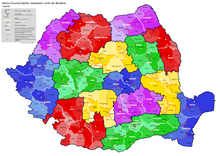 |
|---|
The judiciary of Romania is organized as a hierarchical system of courts, with a civil law system. Provisions regarding its structure and organization are found in the Constitution and Law no. 304/2004 on judicial organization.[1]
The civil courts are organized as follows:
- High Court of Cassation and Justice (Înalta Curte de Casaţie şi Justiţie)
- 15 Courts of Appeal (curţi de apel)
- 41 county courts and the Bucharest Municipal Court (tribunale)
- 188 Local courts (judecătorii).
Each court is run by a court president, who is responsible for its management and public relations. Within most courts there are specialized sections or panels for civil and criminal cases, as well as other areas of the law.
A number of specialized courts (tribunale specializate) also exist, such as the Argeș Commercial Court and the Braşov Family Court. The Constitutional Court of Romania acts as an independent constitutional jurisdiction and is not part of the ordinary court system.[2]
The military court system is organized into three tribunals, the Territorial Military Tribunal and the Military Court of Appeal.[3]


References
[edit]- ^ "ROMANIAN JUDICIAL SYSTEM". Retrieved 22 January 2015.
- ^ "The Court's role and powers". Retrieved 22 January 2015.
- ^ "Presentation of the Romanian judicial system". Retrieved 22 January 2015.
Well, that’s interesting to know that Psilotum nudum are known as whisk ferns. Psilotum nudum is the commoner species of the two. While the P. flaccidum is a rare species and is found in the tropical islands. Both the species are usually epiphytic in habit and grow upon tree ferns. These species may also be terrestrial and grow in humus or in the crevices of the rocks.
View the detailed Guide of Psilotum nudum: Detailed Study Of Psilotum Nudum (Whisk Fern), Classification, Anatomy, Reproduction